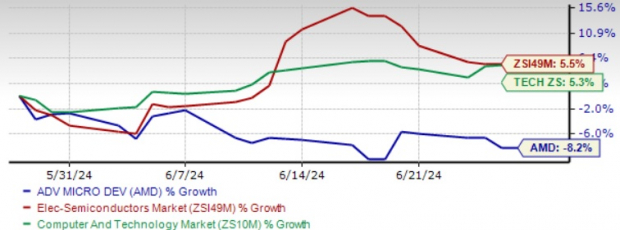Advanced Micro Devices has experienced a notable decline of over 8% in its stock value over the past month. This performance falls short of the Electronics-Semiconductors industry gains of 5.4% and the broader Computer & Technology sector’s return of 5%. In contrast, its main competitor, NVDA, has seen an 11% increase in the same period.
Both AMD and NVDA have been highly favored by investors, primarily due to the surge in demand for GPU chips driven by the widespread adoption of artificial intelligence (AI).
However, recent market sentiment has been unfavorable to AI chip providers, with concerns arising from the complex macroeconomic climate and uncertainties surrounding the upcoming Presidential elections. These factors have exerted downward pressure on the stock prices of chip manufacturers.
AMD, being smaller in size and holding a smaller share of the GPU market compared to NVIDIA, has been particularly impacted. Despite possessing a strong product portfolio, doubts about its ability to compete with NVIDIA in the short term have influenced its recent stock performance.
Evaluating AMD Stock’s Performance Over One Month

Image Source: Zacks Investment Research
Yet, this dip in AMD’s stock price could present a valuable opportunity for investors willing to take on some risk. The AI sector is anticipated to maintain its strength, with increased investments from cloud computing giants such as Microsoft and Alphabet.
AMD’s strategic expansions in its product offerings position it well to challenge NVIDIA not just in the data center segment but also in the expanding AI-powered consumer PC market in the long run.
Assessing AMD’s Strong Portfolio for Long-Term Prospects
At Computex 2024, AMD unveiled its Instinct accelerator roadmap, which includes the upcoming Instinct MI325X accelerator planned for release in Q4 2024.
The next-generation CDNA 4 architecture, expected in 2025, is set to power the AMD Instinct MI350 Series, providing up to 35X better AI inference performance compared to the AMD Instinct MI300 Series with AMD CDNA 3. The CDNA “Next” architecture will support the MI400 series accelerators scheduled for 2026.
Moreover, AMD launched the fifth generation of EPYC server processors (Turin) utilizing the Zen 5 core. It also expanded its range with the introduction of the Ryzen AI 300 Series and Ryzen 9000 Series processors tailored for AI applications across mobile and desktop platforms.
Furthermore, AMD stands to gain from its strong network of partners, with companies like Microsoft, HP, Lenovo, and Asus introducing new PCs powered by third-gen AMD Ryzen AI 300 Series processors and AMD Ryzen 9000 Series desktop processors at Computex.
Challenges of Rising Competition for AMD
NVIDIA’s decision to roll out new AI chip models annually, in contrast to its previous biennial update cycle, intensifies the competition faced by AMD. Additionally, initiatives by tech giants like Microsoft, Alphabet, and Meta Platforms to develop their AI platforms pose further challenges for AMD.
Microsoft’s Maia 100 AI accelerator, designed to handle cloud AI tasks like extensive language model training and inference, boasts a 5-nanometer TSMC core with 105 billion transistors.
Not to be outdone, Alphabet’s Google introduces the Axion central processing unit (CPU) to support its data center AI operations. The Axion processors mark Google’s inaugural tailored Arm-based CPUs aimed at delivering superior performance and energy efficiency.
Meanwhile, Meta Platforms’ Meta Training and Inference Accelerator, a specialized chip series for its AI workloads, supports various new generative AI products and services, recommendation systems, and advanced AI research.
Analysis of AMD Stock’s Valuation
AMD’s stock currently trades at a discount compared to NVIDIA but slightly above the Zacks Electronics – Semiconductors industry average. With a forward P/E ratio of 36.84X for the next 12 months, it falls below NVIDIA’s 43X but edges past the industry’s 34.83X.
Despite these metrics, the current valuation might not be enticing for growth-focused investors in the short term, given the modest growth outlook of this Zacks Rank #3 (Hold) entity. For the complete list of stocks with a Zacks #1 Rank (Strong Buy), follow thislink.
AMD’s revenue projections for the second quarter of 2024 are in the range of $5.7 billion (+/-$300 million). This would represent a roughly 6% year-over-year increase and a 4% sequential growth rate.
The Zacks Consensus Estimate for the same period places revenues at $5.71 billion, indicating a 6.54% growth compared to the previous year. Earnings-wise, the consensus sits at 66 cents per share, down a few cents from the previous month.
Free Report: Analysts might be underestimating certain stocks, with potential earnings announcements leading to jumps of +10-20%. Discover more now.
